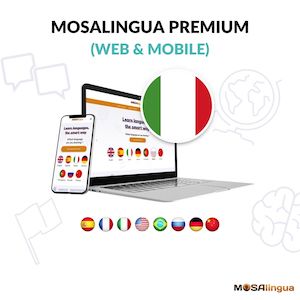Vocabulary should be at the top of your to-do list when you begin learning Italian. But for most learners, learning vocab is a means to an end: interaction with real people in Italian! Whether you’re planning a trip to Italy or simply want to get a grasp on the basics of the language, these 10 basic Italian phrases are a great place to start, because you can use them in tons of everyday situations. By the end of this article, you’ll already be able to communicate in Italian. Don’t believe me? Read on!

Italian for Beginners: 10 Need-to-Know Basic Italian Phrases
Be sure to write these common Italian phrases down somewhere, or add them to the learning stack in your MosaLingua app if you want to memorize them the easiest way possible!
Salve! – Hello!
Listen:
Like in most languages, there are a few different ways to greet someone in Italian, based on how well you know them, the time of day, and the occasion.
Salve is a versatile way to say hello in Italian, and you can use it no matter what time it is or who you’re speaking to.
You could say buongiorno, which also means hello, but that’s only used in the morning.
Or ciao, but it’s much too informal for certain people and situations.
That’s where salve comes in to sa(l)ve the day! 😉
This is a word you can use any time, both during the day and at night, with friends, when entering a shop, or even in situations that call for a more formal register. Say it with a smile and you’ll set the tone for a positive interaction in Italian!
Come va? – How are you?
Listen:
Here’s another expression you should have up your sleeve. It’ll allow you to ask how someone is in a variety of situations. (Don’t forget to say hi first!)
In Italian, there are different ways to ask this question depending on who you’re addressing. This is something English speakers struggle with, because “How are you?” works for any level of formality.
For instance, in Italian, if you don’t know the person you’re speaking to, you should use the 3rd person to signal that it’s a polite question: “Come sta?”
On the other hand, “Come va?” works for both friends you’ve known for years and people you’ve just met.
It’s also a cool question because the person can choose to add something, rather than just replying bene (good) ou male (bad). It shows that you’re interested in what they have to say, and can lead to more interesting conversations!
Non lo so. – I don’t know.
Listen:
“Non lo so” looks a lot like the common Spanish phrase “No lo se,” and it means the same thing. If someone asks you a question you don’t know the answer to, simply reply “Non lo so“: “I don’t know”!
Let’s say your new Italian friend asks you: “Vuoi andare al cinema o al museo?” (Do you want to go to the movies or the museum?) but you’d rather let her decide. “Non lo so, tu che vuoi fare?” (I don’t know, what do you want to do?) is a perfectly good answer.
You can also shorten it to “Non so”, and drop the lo, if you’re not too sure about what they’re saying or asking. For example:
“Vuoi andare a vedere una commedia romantica?” (Would you like to see a rom-com?)
“Non so… preferisco un horror.” (I don’t know… I’d rather see a horror movie.)
Start improving your Italian today
Good news: we can help!
More good news: you can get started for free! With your free trial, you can test drive the most effective method for learning Italian for the next 15 days!
Vocabulary flashcards, videos with subtitles, audiobooks, articles adapted to your level – with MosaLingua Premium (Web & Mobile), you’ll have access to all this and more. Get started right now. It’s free—and risk-free—to try!
Comunque… – So/say/anyway/hey…
Listen:
Comunque has multiple meanings, but also… doesn’t really mean anything.
Comunque can mean “however,” “nevertheless,” “even so,” “in any case” and more. But in the everyday vernacular, it’s a catch-all word that people use to introduce new information or change the subject.
If you start throwing this word into conversation, you’ll really sound like a native speaker! Keep an ear out for it and you’ll hear it everywhere! It’s an incredibly common Italian phrase.
Here’s an example:
“Comunque, hai visto quanto è cresciuto mio nipote?” (Hey, have you seen how big my nephew has gotten?)
Quanto è? – How much is it?
Listen:
Unless you’re Elon Musk, you’ll probably want to know how much that yummy salami (dried sausage) or that beautiful bouquet of flowers is going to set you back. For us regular folks on a budget, it’s important to be able to ask for the price of things. Using this handy phrase, you’ll be able to ask for the check at a bar, ride in a taxi, or decide if you can splurge on that Como silk scarf.
“Quanto è?” (How much is it?) is even easier to learn and say than “Quanto costa?” (How much does it cost?) or “Qual è il prezzo di…” (What is the price of…?).
It’ll make your life just a little bit easier, and it’s a basic Italian phrase that real Italians use each and every day.

Vorrei… – I would like…
Listen:
Here’s a word you can use to express all of your wants and needs, and do so in a way that won’t put people off. Instead of saying “I want” (voglio), which isn’t the most polite, use vorrei, which means “I’d like.”
Just make sure you use it correctly! It’s a conditional:
- Vorrei un caffè, per favore (I’d like a coffee, please.)
- Vorrei vivere in Italia (I would love to live in Italy.)
It’s never a bad thing to be TOO polite, so we recommend pairing this expression with per favore (please), grazie (thank you) and prego (you’re welcome) – depending on the context, of course, and not all at once!
Posso…? – Could/Can/May I…?
Listen:
To ask for something in a nice way, there’s another verb that will also come in handy: posso (I can). It’s especially polite with per favore (please) tacked onto the end. There are a million different ways to use it!
Here are just a few examples:
- Posso chiedere un’informazione? (Could I ask you something?)
- Posso venire con te al cinema? (Can I come to the movies with you?)
- Posso avere un caffè per favore? (May I have a coffee, please?)
It’s a need-to-know verb!
Mi scusi – Excuse me/Sorry
Listen:
You’ve probably already heard scusi or scusa, which sort of look like “excuse” in English. That’s because they both come from the Latin excūsō. So you can probably guess what “Mi scusi” means. “Excuse me,” “sorry,” or “pardon me.”
It’s another basic Italian phrase you’ll hear a lot because it’s appropriate for many different situations. Like in English, you can use it to get someone’s attention, like your server if you want to order another cappuccino, or if you want to ask someone in the street for directions. It’s also great for apologizing when you bump into someone, or asking someone to scoot over so you can get by them:
- Mi scusi! (Sorry/Pardon me!)
- Mi scusi, il mio treno sta partendo! (Excuse me, my train is leaving!)
The more informal version, scusa (sorry), can be used to apologize, of course. But you can also use it as a question, if something isn’t clear or if something has come as an unpleasant surprise:
- Scusa? Non ho sentito. (Pardon? I didn’t hear that.)
- Scusa!? Perché non vieni più al mare con me? (I’m sorry!? Why aren’t you coming to the beach with me anymore?)

Meno male… – Thankfully…/Thank goodness!
Listen:
This is a very common idiomatic expression. That means that the real meaning of the expression has nothing to do with its literal meaning. We use “meno male” to mean “per fortuna” (thank God, or thankfully) or to express relief or happiness. So don’t think about the words that make up this expression, but learn how to use it in the right context and you’ll speak like a true Italian!
For example:
- Meno male che ho preso l’ombrello, adesso piove! (Luckily I brought my umbrella, it’s raining!)
- Hai trovato i tuoi occhiali? Meno male! (Did you find your glasses? Thank goodness!)
- Devo migliorare il mio italiano, meno male che c’è MosaLingua! (I need to improve my Italian. Thankfully there’s MosaLingua!)
A presto!
Listen:
All good things must come to an end, even your conversations with your new Italian friends.
To say so long, you’ve probably learned Ciao! If you’ve already studied a bit of Italian, you should know that you can also say arrivederci (goodbye) and ci vediamo (see you later).
But there’s another way to say goodbye, which implies that you’d like to see the person again soon: “a presto” or “ci vediamo presto” (see you soon). It’s very commonly used in Italy. It even works for phone calls! And it’s super easy to remember, even for beginners.
We hope these 10 frequently used phrases will help you out in your everyday conversations. One last tip: try to use them as quickly as possible, so that your vocabulary has a solid foundation.
BONUS Video: 10 Basic Italian Phrases You’ll Use on a Daily Basis | Italian for Beginners
Review all these basic Italian phrases with Mara, our marvelous Italian teacher, in the video she made just for you. She recorded it in Italian to help train your ear and give you some extra listening comprehension practice, but feel free to turn on the subtitles if you need them. They’re available in Italian, English, and four other languages. Click the Settings gear to toggle them on and off.
Subscribe to our YouTube channel for more useful videos like this one!
Next Steps
If you liked this article about basic Italian phrases, you might also like:
- How to speak Italian (and not just with hand gestures!)
- Numbers in Italian up to 100 + tips to learn them!
- Learn the days of the week in Italian with pronunciation and examples
A presto!





Comments